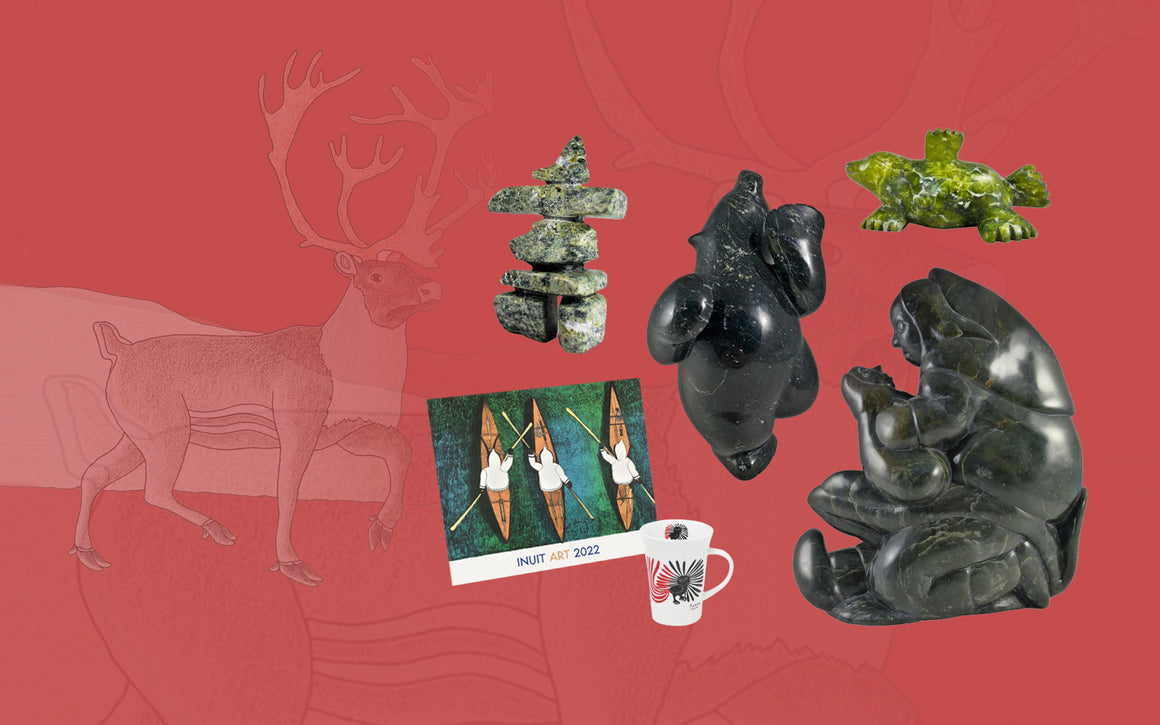Events
2012 spring collection from Kinngait
Four graphic representations set up the new 2012 spring print collection from the Kinngait (Cape Dorset) studios. This collection is a tribute to four artists from the first generation of drawers: Kiasu Kiasu or Kiakshuk Kiakshuk*(1886-1966), Ilisusi Parr or Eleeshushee Parr** (1896-1975), Kananginaaq Putuguq or Kananginak Pootoogook (1935-2011), and Qinuajuaq Asivak or Kenojuak Ashevak (born in 1927 she is the most senior member of the community).
These four prints were made from original drawings created by Kiasu in 1964, Ilisusi in 1966, Qinuajuaq in 1961, and Kananginaaq in 1982. They were selected from the Dorset Fine Arts archives to be reproduced onto prints with stonecut and/or stencil. Like the most of images from the first generation of Inuit artists, figures are isolated on a blank paper, shown from different point of view with mixed perspectives and essential elements depicting the topics.
« Chasing Geese into Pens » by Kiasu Kiasu (1964)
Humans daily life, mostly camps representations as well as hunting scenes, were an important part of Kiasu’s iconographic topics (Barz 2003). His depiction here let us imagine how geese were captured during summer or spring time. The artist drew two large circles representing pens built with stones where geese were pushed toward by hunters. To chase birds was often considered as an activity for children and women. As Kiasu depicted his figures with detailed clothes, we know that they are children or young men while they wear atigiit (outdoor men clothes).
« Boy Playing with Dogs » by Ilisusi Parr (1966)
This depiction shows a young boy playing with dogs. Like all young Inuit boy, he plays simulating a hunting scene thus, comparing dogs with game (maybe caribous?) which the boy is going to harpoon. Imitating male hunters is a strong part of educational practices among Inuit culture (Petit 2011); it is called in Inuktitut angunasunnguaq-, meaning « imitating male hunter » thus, playing caribou hunting (tuktunnguujaq-, tuktunnguaq-), walrus hunting (aivinnguujaq-), seal hunting (nattinnguujaq-, nattinnguaq-) or polar bear hunting (nanunnguujaq-). As the original drawing was printed by stencil, forms are soft with few details only depicting eyes, mouth and noise of boy and those of animals.
« Mother Earth » by Qinuajuaq Asivak (1961)
This topic is a traditional one among Qinuajuaq’s drawings and Inuit art, commonly called « transformation scene ». The title here « Mother Earth » was actually not given by the artist as this is a Western notion from Latin Epicurean philosopher Lucrece who firstly introduced it in his book De rerum natura (« The Nature of Things ») published in Istcentury before Christ. Well, this topic here is about a spirit entity or a shaman made up of elements from a human, birds, and dogs, wolfs or foxes. While Qinuajuaq uses to say that her representations usually come from her imagination (Vladykov Fisher 2008), following the Inuit culture all living beings such as humans, animals and spirits, could change their appearance only by thoughts thus, mixing together their bodies. Maybe Qinuajuaq depicted here a strong female shaman or a strong female spirit helped by many birds and foxes, wolfs or dogs. Indeed, the figure wears an amauti (female clothes with large hood), while she has a long tail with wings and large feathers. She gives a large smile while she is bringing several mixed animals like a trophy.
« Conference of Owls » by Kananginaaq Putuguq (1981)
This artwork shows the daily life of snow owls (ukpik or ukpijjuaq in Inuktitut). This is a common topic through Kananginaaq’s drawings as well as many artists within Inuit artmaking. Even snow owls are often major actors within oral myths like crows (tulugaq or tulugarjuaq) as the only two sedentary birds in the Arctic, Kananginaaq used to depict snow owls in their natural environment rather than representing traditional stories. The first Kinngait Print collection in 1959 included the first print Kananginaaq made, which was produced in collaboration with his father Putuguq, and his work has been included almost every year since then. Through the years, Kananginaaq added more and more details into his drawings, also keeping snow owls as one of his favorite subject (Vladykov Fisher 2008).
* [Kiasu is a different artist from the printmaker Qiaksuk Lukta (1928-2004), who used to print Kiasu’s drawings. The first signed Kiasu in Inuktitut while the second signed Lukta to make the difference between both.]
** [Ilisusi Parr is not the well-known drawer Parr (1893-1969), that is why the first one used to sign his drawers as Ilisusi whereas the second one signed only by Pa into syllabics Inuktitut.]
References
BARZ, Sandra B, (ed.), 2003, Inuit Artists Print Workbook. Volume III, Book 2. New York: Arts & Culture of the North.
PETIT, Céline, 2011, Jouer pour être heureux. Pratiques ludiques et expressions du jeu chez les Inuit de la région d’Iglulik (Arctique oriental canadien), du XIXe siècle à nos jours, thèse de doctorat, Université Laval et université Paris Ouest Nanterre [unpublished].
VLADYKOV FISHER, Kyra, 2008, Guide to Cape Dorset artists. Cape Dorset: Municipality of Cape Dorset.
Kinngait (Cape Dorset) Annual Print Collection 2011
The new annual print collection from Kinngait (or Cape Dorset in English) is now available down in our gallery Inuit Art Zone. Eleven Inuit drawers and six printmakers contributed to this collection. Those are elders and younger artists who are well-known among the international art market. Kakulu Saggiaktok, Kanaginak Pootoogook, Kenojuak Ashevak, Malaija Pootoogook, Ningeokuluk Teevee, Ohotaq Mikkigak, Papiara Tukiki, Pitaloosie Saila, Shuvinai Ashoona and Tim Pitsiulak are the drawers who realized the original drawings that were printed by Niveaksie Quvianaqtuliaq, Qiatsuq Niviaqsi, Pitseolak Niviaqsi, Qavavau Manumie, Beatriz Sobrado Sámano and Cee Pootoogook.
A tribute to Kananginak Pootoogook
This annual print collection from Kinngait is dedicated to Kananginak Pootoogook who passed away last November. Son of the great Ikiqrasaq camp leader, Pootoogook, Kananginak came to Kinngait in 1958 when the printmaking program was launched on Baffin Island, with the help of James Houston. He started carving, drawing and printmaking at this time, paying more and more attention in promoting Inuit language and culture as he was sharing Inuit values through the art making. He had actually a strong conscious of the power of art that he considered as an essential medium to keep alive the Inuit way of life (from the nomadic past to the present time). Kananginak Pootoogook became one of the most famous Inuit artists among the world art scene who devoted his life to build a local independent economy through the development of the West Baffin Eskimo Cooperative in Kinngait being its president for decades.
The spring collection (included in the annual print collection) raises 17 linocuts based on Kananginak’s original drawings: this limited edition is untitled in Inuktitut Aulajijakka(that means “the things I remember”). The topics depicted here by the artist are related to personal experiences with family camp scenes such as iglu (snow house) building, Inuit winter games, cutting up game, hunting sea mammals, protecting themselves against bears, or traveling on the land by sled dogs. These artworks are a strong testimony from an Inuit elder who was a leader among the Canadian Arctic and who still inspires young generations.
Inuit Art at the McMichael Canadian
The McMichael Canadian Art in Kleinburg (Ontario, Canada) is devoted to collection and exhibiting only Canadian art, including First Nations and Inuit art. The McMichael’s Inuit Art Collection is a major public resource that attracts researchers on Inuit art and culture, committed collectors and art galleries.
The Inuit art collection of the McMichael includes paintings, prints, drawings and sculptures created in the Canadian Arctic, using many different materials and individual styles. The gallery’s permanent collection is supplemented by the long loan of 100 000 drawings, prints and sculptures from the West Baffin Eskimo Co-operative Ltd, based in Kinngait.
A current exhibition is devoted to Inuit art entitled “Kenojuak: From drawing to print”, until November 30, 2008. This event examines Kenojuak’s involvement with the Kinngait printing program by comparing a selection of the artist’s drawings to their subsequent prints. Focusing on the collaborative relationship between artist and printmaker, this exhibition contains 11 drawings and 11 prints realized by Kenojuak.
“Kenojuak, like most Inuit graphic artists, relies on the considerable skills of print shop staff to transfer her drawings into prints. At times, changes made to the original drawing compositions are minimal, but during the early 1970s, extensive changes were made, particularly in the use of color and markings” notes Shana White, McMichael’s Assistant Curator who curated the exhibition.
The McMichael proposed recently an exhibition focussed on the early experiment in printmaking launched in the winter of 1957 and on the resultant small series of prints by a dozen artists in 1958. This exhibition was entitled “Saumik: James Houston’s legacy”.
The McMichael officially opened in July of 1966, in Kleinburg (Ontario, Canada). Formerly, private collectors built their art collection dedicated to Canadian artists when they started purchasing in 1955 the artworks of Lawren Harris, Tom Thomson, the Group of Seven and their contemporary. Other the years, the collection has continued to grow including First Nations and Inuit art; expending now through purchases and donations from private and corporate art collectors.
Reference:
The Espace Culturel Inuit in Paris inaugurated its new premises at the Canadian Cultural Center
The Espace Culturel Inuit (The Inuit Cultural Space) inaugurated on March 28th 2008 its new Parisian sub-branch at the Canadian Cultural Center (5 rue de Constantine, 75007 Paris). “A large number of our partners wished to celebrate this event with us!”, notices enthusiastically one of the person in charge of the Espace Culturel Inuit.
Lisa Koperqualuk, an Inuit collaborator from Nunavik, was invited on this occasion during she proposed a round-table, thus splendidly explaining the importance of the economic development for Inuit in front of guests’ hundred, among whom personalities from political, cultural, artistic, scientific and university circles.
The Espace Culturel Inuit defines itself as a place of exhibition, information and documentation, opened to the public and dedicated to the promotion of the Inuit culture in France and in Europe. For example, the responsible for The Espace currently intervene in secondary schools on the notions of culture and identity through the discovery of the Inuit culture and of those of the students within the framework of the project “Passeport Discouverte Année Polaire”. They also work on the event “Rendez-Vous Polaires – en Terres Inuit” organized around an Inuit prints exhibition planned on June 2008 (see article of March 26th).
The Prime Minister of Nunavut Paul Okalik visited the new premises of the Espace Culturel Inuit few days later its opening and said himself “delighted that The Inuit Cultural Space found a new roof”. Previously localized in the 19th arrondissement, The Espace had recently had to close its doors due to the lack of financial resources. Let us remember that the creation of The Espace Culturel Inuit results from the initiative of the non-profit Association Inuksuk. Created in 1995, Inuksuk counts members' hundred today and is managed by about fifteen of graduates in Inuit culture and language at the Institut Nationnal des Langues et Civilisations Orientales (Inalco).
The persons in charge of The Cultural Space Inuit lean their competences both on the association of their multidisciplinary and international university training and on their recent experiences in Inuit territories. But the dynamics of their actions results especially from the will to share their common passion for the Inuit culture and the Arctic.
Do not hesitate to visit The Espace Culturel Inuit in Paris, premises or web site depending where you are: you will be warmly received there! Tungasugitsi! Be very welcome!
Espace Culturel Inuit, in Centre Culturel Canadien
5 rue de Constantine
75 007 Paris, France.
Métro Invalides
Kenojuak Ashevak Honoured Again
Kenojuak Ashevak, well-known Inuit artist from Kinngait (Cape Dorset) in Nunavut received on Friday, March 28 in Ottawa the Governor General’s Awards in Visual and Media Arts, Canada’s foremost distinctions for excellence in these artistic disciplines, were created in 1999 by the Governor General of Canada and the Canada Council for the Arts.
“I just take these things out of my thoughts and out of my imagination, and... not try to show what anything looks like in the material world... It's more an interplay of form and colour” Kenojuak explains about her art.
She is probably the best known and most acclaimed of all the Inuit artists who have emerged in the North in the last half century. Her own story is as remarkable as the story of Kinngait and its printmakers and sculptors. Many of Kenojuak Ashevak’s drawings, prints and sculptures have become icons, etched into the public consciousness.
Her bold shapes, bright colours and fantastical creatures have endured for some 50 years, reflecting a unique vision and a special relationship to the land. Born in 1927 in Ikerrasak, a campsite on southern Baffin Island, she lived a traditional nomadic life on the land before settling her family in Kinngait where she still lives.
Kenojuak Ashevak was featured in a National Film Board production, Eskimo Artist – Kenojuak, and her graphic images have been used on Canadian stamps. She is a Companion of the Order of Canada, a member of the Royal Canadian Academy and the recipient of two honorary doctorates. Her sculpture, drawings and prints are found in all major Canadian collections as well as international museums such as the Metropolitan Museum of Art in New York.
The National Gallery of Canada, in collaboration with the Canada Council for the Arts, presents an exhibition devoted to the eight winners of the 2008 Governor General’s Awards in Visual and Media Arts : Kenojuak Ashevak, Serge Giguère, Chantal Gilbert, Michel Goulet, Alex Janvier, Tanya Mars, Eric Metcalfe And Dr. Shirley Thomson. Representing the practices of some of Canada’s leading artists working in painting, performance, video, sculpture, drawing, printmaking, fine craft and film, the exhibition showcases a selection of some 25 works.


